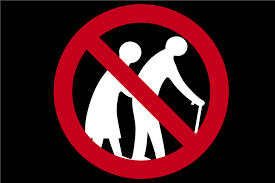26 of the 48 state Medicaid agencies studied could not report the number of “critical incidents” — such as abuse, neglect or exploitation.
You are here
Why are older adults demeaned by the health and tech industry?
 What is the point of sneering at older people? Rant on. Consider an upcoming HIMSS event in Orlando with the charming title: Monitoring Grandma: Adoption of Connected Health Tech by Seniors. That version of the title is spelled out here because the presenter has been alerted and agreed the title was condescending – so MAYBE it will be changed. But this is just the tip of the condescension iceberg: Go ahead, Google ‘technology grandma’. Just check out the first page or two of the millions of identified references – including the images of older women ‘holding it wrong’ or ‘ confused.’
What is the point of sneering at older people? Rant on. Consider an upcoming HIMSS event in Orlando with the charming title: Monitoring Grandma: Adoption of Connected Health Tech by Seniors. That version of the title is spelled out here because the presenter has been alerted and agreed the title was condescending – so MAYBE it will be changed. But this is just the tip of the condescension iceberg: Go ahead, Google ‘technology grandma’. Just check out the first page or two of the millions of identified references – including the images of older women ‘holding it wrong’ or ‘ confused.’
Despite the user interface complexity, smartphone adoption by seniors is rising. Pew hasn’t bothered lately, but AARP recently published a survey of tech ownership among the 50+. This time the breakdown included age 70+ as a segment in which 62% own a smartphone. Not too surprising, when you consider that the neighborhood store display of feature phones for Verizon has, uh, shrunk to just one. Meanwhile, the average age of a first time grandparent in the US is 50 and by age 65, according to AARP data, 96% are grandparents. Think of that as you study the Shutterstock images of what grandma presumably looks like.
Back to monitoring, connected health or otherwise. Because technology can be used for a monitoring purpose, inventors make it so. Sensor-based home monitoring was a 2007-ish innovation. Perhaps inventors had or today have a grandmother who fell down, wanting to prevent others from having a similar experience. This is laudable. Telehealth was a pioneering concept in 2008. In 2020, telehealth (and its other prefixes and monikers like Remote Patient Monitoring or RPM) became an accepted service with valid reimbursement codes. Yet adoption is slow – reasons and excuses are many. One of those reasons surely has to do with the willingness of the older person to be monitored unless mandated. How do tech firms and insurers overcome this reluctance? With persuasion? Threats? Perhaps providing the older person with a positive experience might work.
The home visit – no tech result. Meanwhile, Medicare Advantage plans telemarket home nurse visits which provide an opportunity to assess risk scores, enabling insurers to boost their reimbursements from Medicare based on the assessment, independent of whether the insured has already been recently treated at the doctor’s office. Do these visits result in recommendations for telehealth? No – they are independent of patient care. The 2017 Harvard article indicates that 1 million had signed up for these home nurse visits – but there were 19 million people covered by Medicare Advantage plans in 2017. That’s only 5 percent! That means most people said no, sometimes repeatedly, despite aggressive efforts to schedule. Perhaps grandma may not want to be checked up on, that is, monitored, either by 'connected health' or other forms of oversight that do not demonstrate clear benefit to the individual being monitored – and surely without the all-important 'Opt in.' Perhaps marketers of monitoring tech for older adults could include something of direct benefit to them? How about free Wi-Fi and a smart speaker? Just saying. Rant off.
[See latest report, Voice, Health and Wellbeing 2020]

Comments
From Mark Cayle
Agreed! I started working on ONKÖL 10-years ago and no one knew what RPM was. Now, with BeHomeSafe, we are seeing that tech is much more welcome in people’s homes... as long as they don’t feel intruded upon. Our proprietary in-home assessment, personal installation and training with our Members make it much more attractive and accepted because we treat them with the dignity and respect they deserve. We feel that this personal touch, rather than shipping a tech device to the front porch, like everyone else, makes a huge difference.
From Richard Marshall
This is a very thought provoking rant (in a good way!).
I feel there can be cultural gaps between techno-push and senior-needs-pull which is not discussed enough in deliberations by many startups.
Mark Cayle's sentiments are
Mark Cayle's sentiments are laudable. Our experience with Cutii matches what you are saying: it is about human connection, trust and confidence. Not just shipping boxes.
Ageism...
Great rant! As someone who works with this population to help them navigate their technological devices, ( https://patientsympatheticcoaching.com ) and work to encourage the same group to share housing ( https://sharinghousing.org ) I've been horrified by the "monitoring" options for seniors. No one wants to be "monitored." UGH.
Smart phones: I'm finding the older folks using them rather than computers. Text, email, and internet searches are the full needs.
Stat: 96% are grandparents by the age of 65.? Something is off. Approximately one-third of boomers never had children..
Grandparents
That is the link to AARP, but you're right -- it may simply be AARP members surveyed.
https://www.aarp.org/research/topics/life/info-2019/aarp-grandparenting-study.html